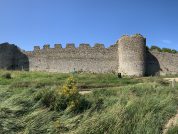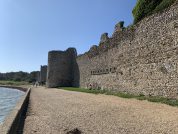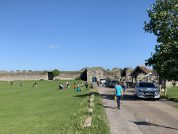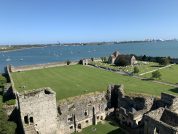Portchester (Portus Adurni) Roman Fort
Saxon Shore Fort
Portus Adurni was a Roman fort in the Roman province of Britannia situated at the north end of Portsmouth Harbour. It was part of the Saxon Shore, as its outer walls remain almost complete it is the best-preserved Roman fort north of the Alps. Around an eighth of the fort has been excavated.
History of the Roman Fort at Portchester (Portus Adurni)
In the 3rd Century AD, raiding Saxon pirates began to raid the coasts of Roman Britain. To defend the province the Romans were maintained a fleet in the English Channel and the North Sea which was supported by a series of Forts and watch towers around the coast. Coin finds suggest that the Roman Fort at Porchester was built between AD285 and AD 29o on the order of Marcus Aurelius Carausuis. In AD 286 Carausuis rebelled and proclaimed himself emperor of Britain and parts of Gaul. In AD 293 he lost his lands in Gaul and later that year was assasinated by a follower called Alectus, who in turn ruled britain. In Ad 296 the province was brought back under Roman control after a full scale invasion.
Who Occupied the Roman Fort at Portchester (Portus Adurni)
Roman forces used the fort occasionally, and we know from archaeological evidence that civilian communities mainly occupied it. Within its walls they built timber houses and workshops surrounded by animal pens, cesspits and rubbish heaps.
The Garrison Unit(s) of Roman Fort at Portchester (Portus Adurni)
There are no inscriptions on stone recorded in the R.I.B. for Portchester. The only evidence we have which mentions the name of any of the garrison units at Portchester occurs in the Notitia Dignitatum, where the Portchester entry is the last listed “at the disposal of the Right Honorable Count of the Saxon shore in Britain”. The full text is shown below.
“The commander of the Company of Scouts at Portus Adurni“
The Portchester Defences
The Roman fort had a square perimeter with 20 projecting regularly places D-shaped towers, of which 16 still remain. The projecting D shaped towers of the Roman fort of Portchester were a novel feature of Roman Military architecture of the time.Its gates were set midway along each wall. The principal gates were to the east and west and postern gates to the north and south. The corners are angular and the bastions, which are U-shaped, are hollow. The walls are 10 feet thick and provided with bonding-courses; they stand in places over 20 feet high. The enclosed area is about 8 acres.
The walls are topped with a medieval walkway which was not present in the Roman period.
Classical References to Roman Fort at Portchester (Portus Adurni)
The first time the Roman name for the Portchester Saxon Shore Fort is mentioned is in the Notitia Dignitatum of the late-4th/early-5th centuries, where it appears as Portum Adurni, following the entry for Anderitum (Pevensey, East Sussex). The Portchester fort is last mentioned in the Ravenna Cosmology of the seventh century as Ardaoneon (R&C#43), between the unidentified station Armis and the entry for Navimago Regentium (Chichester, Sussex).
References for Roman Fort at Portchester (Portus Adurni)
- The Archaeology of Roman Britain by R.G. Collingwood (Methuen, London, 1930).
Roman Roads near Roman Fort at Portchester (Portus Adurni)
None identified
Sites near Portchester (Portus Adurni) Roman Fort
- Hayling Island Temple (10 km)
Temple Or Shrine - Butser Ancient Farm (15 km)
Museum - Bosham Harbour (Magnus Portus) (18 km)
Port - Clausentum (Bitterne) (21 km)
Port and Roman Burg - Isle of Wight (Vectis Insvla) (21 km)
Saxon Shore Fort and Villa - Fishbourne Roman Palace (Villa Regis Cogidubni) (21 km)
Supply Depot and Villa - Stroud Villa (22 km)
Temple Or Shrine and Villa - Chichester (Noviomagus Reginorum) (24 km)
British Capital and Port - Selsey Bill Settlement (26 km)
Probable Settlement - Onna? (Nursling) Settlement (28 km)
Possible Roman Settlement





